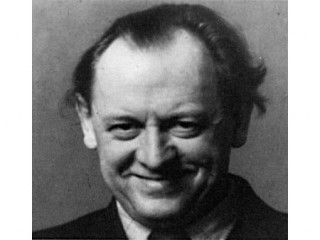
Kurt Schwitters biography
Date of birth : 1887-06-20
Date of death : 1948-01-08
Birthplace : Hannover, Germany
Nationality : German
Category : Famous Figures
Last modified : 2011-09-09
Credited as : artist painter, typographer, poet, MERZ-art
The painter, collagist, typographer, and poet Kurt Schwitters was the creator of MERZ-art, which is two and three dimensional collage-like works using paper and discarded objects of everyday use.
Kurt Schwitters was born in 1887 in Hannover, Germany. His parents were reasonably well-to-do retailers who made possible his studies at the Arts and Crafts school in Hannover and four years at the Art Academy in Dresden (1909-1914). He then settled in Hannover, married Helma Fischer, served for a short time in the army, and turned away from figurative painting and began to write his first poems. In 1918 he created his first "MERZ" picture. The name derived from a piece of paper with the word "Kommerz"—the letter-head of a bank—which formed part of the collage. He had his first exhibition of these new works in 1919 at the famous Der Sturm Gallery in Berlin, directed by Herwarth Walden, who was also the editor of the Sturm journal. Schwitters' only son Ernst was born while Schwitters studied two more semesters in Hannover. In 1919 he published several articles and poems in the Sturm journal, including his famous "Anna Blume" poem, and established friendships with several avant-garde artists in Germany. His apolitical stance caused Richard Huelsenbeck, one of the leaders of the Berlin Dada group, to exclude him from their activities, but the friendship with another member of this group—Raoul Hausmann—lasted through Schwitters' lifetime. In 1920 the Societe Anonyme of Katharine Dreyer in New York showed some of Schwitters' works for the first time in the United States.
At the Dada congress in Weimar in 1922 he met the Dutch artist Theo van Doesburg and thus established connections with the De Stijl movement. In 1923 he began to publish (in irregular intervals) the MERZ magazine and saw the first of his works bought by a museum (Dresden). In 1924 a record was cut of his recitation of the "Ursonate," a sound-poem in the Dada tradition, originally inspired by Raoul Hausmann.
At this time Schwitters began to work on his MERZ column (which he called "Cathedral of Erotic Misery" [Kathedrale des erotischen Elends]), a stalactite-like three-dimensional construction of many different materials which
filled not only his studio but grew so high that the removal of the ceiling became necessary for its further expansion. The witty title referred in part to the many small "caves" (later covered) in which he imbedded small objects which were tokens of memory to various friends as well as objects which he found here and there. He considered this sculpture the most important part of his life's work; it was destroyed by bombs during World War II. He started a second one during his exile in Norway (which was destroyed by fire) and a third one in England. From 1930 on he spent considerable time every year in Norway, emigrating there in 1937 after the Nazis had confiscated 13 of his works from various museums and exhibited four of them in the infamous "Degenerate Art Exhibit" in Munich in 1937. When the Germans invaded Norway in 1940 he escaped to England, where he was for 17 months, after which he lived with his son in London. After suffering a stroke in 1944 he moved to the Lake District. In 1945 his wife died in Hannover. The Museum of Modern Art in New York, which had exhibited his works since 1936, provided him a grant to recreate the MERZ column. After prolonged illnesses, Schwitters died on January 8, 1948, in Kendal near Ambleside, England.
Schwitters' fame rests on his MERZ pictures, his collages and assemblies, the MERZ column (preserved only photographically), and his poetry, as well as on his inventiveness as a typographer and advertising designer. He freed the various materials from their original intent and fused them into singular works of art. A stylistic development can be recognized moving from the early expressionistic collages and drawings to the incorporation of constructivist and De Stijl (The Style) elements. His humor and wit (some-times expanded to the titles of his works) can also be seen in his charming children books (in collaboration with Kate Steinitz). It is revealing that from 1918 on Schwitters incorporated in his works the discarded trash of the everyday, thus creating something like an analogue to the old Germany's collapse after World War I. He always believed that art represented liberation and should provide enjoyment at the same time. That the general public was shocked by his works as well as by recitations of his poetry (often taking on the forms of an "event"), he accepted, since art was to him "a spiritual function of man with the task to liberate him from the chaos and the tragedy of life…."


















